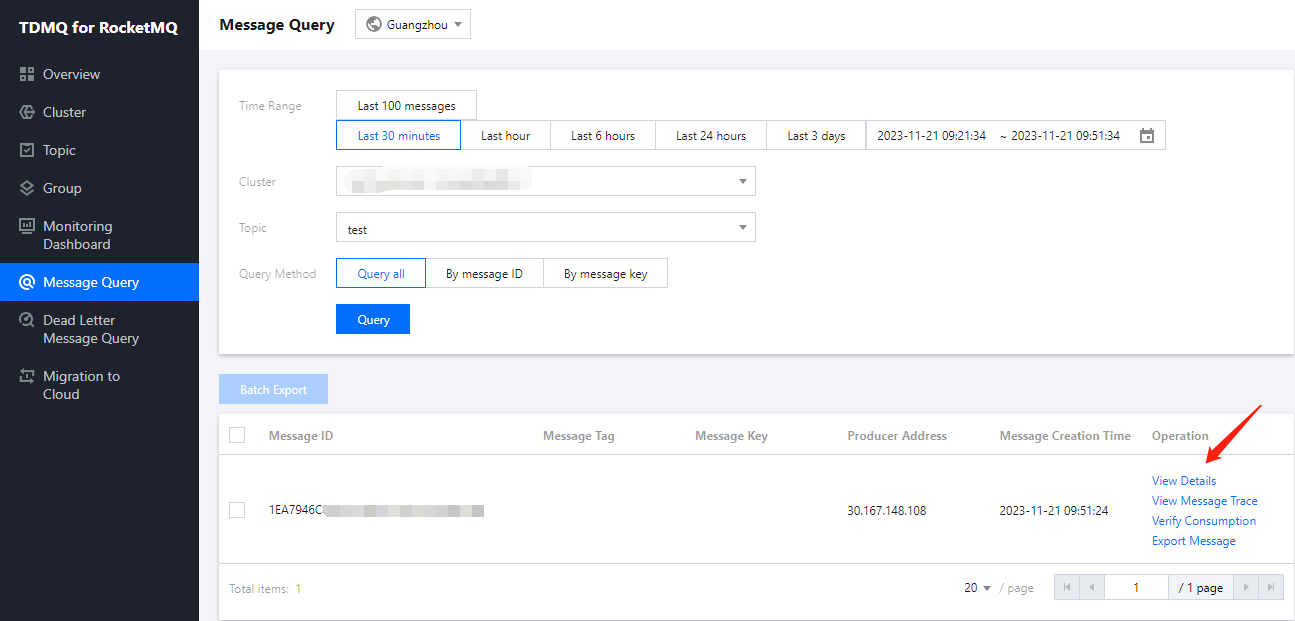- Release Notes and Announcements
- Product Introduction
- Purchase Guide
- RocketMQ 5.x
- RocketMQ 4.x
- Product Introduction
- Purchase Guide
- Getting Started
- Operation Guide
- Development Guide
- SDK Documentation
- Migration to Cloud
- API Documentation
- FAQs
- TDMQ FOR ROCKETMQ SERVICE LEVEL AGREEMENT
- Contact Us
- Release Notes and Announcements
- Product Introduction
- Purchase Guide
- RocketMQ 5.x
- RocketMQ 4.x
- Product Introduction
- Purchase Guide
- Getting Started
- Operation Guide
- Development Guide
- SDK Documentation
- Migration to Cloud
- API Documentation
- FAQs
- TDMQ FOR ROCKETMQ SERVICE LEVEL AGREEMENT
- Contact Us
Overview
This document describes how to use an open-source SDK to send and receive messages with the Golang SDK serving as example, for you to better understand the complete process of message sending and receiving.
Note:
The Golang client is used as an example. For clients of other languages, see the SDK Documentation.
Prerequisites
You have created and prepared the required resources.
Directions:
Step 1: Installing the Golang Dependency Library
Incorporate the relevant dependencies in the Golang project.
go get is used as example. Run the following command:go get github.com/apache/rocketmq-clients/golang/v5
Step 2: Producing Messages
package mainimport ("context""fmt""log""os""strconv""time"rmq_client "github.com/apache/rocketmq-clients/golang/v5""github.com/apache/rocketmq-clients/golang/v5/credentials")const (Topic = "xxxxxx"// Set Endpoint to the access address provided by Tencent CloudEndpoint = "xxxxxx"// Add the configured ak to AccessKeyAccessKey = "xxxxxx"// Add the configured sk to SecretKeySecretKey = "xxxxxx")func main() {os.Setenv("mq.consoleAppender.enabled", "true")rmq_client.ResetLogger()// In most case, you don't need to create many producers, singleton pattern is more recommended.producer, err := rmq_client.NewProducer(&rmq_client.Config{Endpoint: Endpoint,Credentials: &credentials.SessionCredentials{AccessKey: AccessKey,AccessSecret: SecretKey,},},rmq_client.WithTopics(Topic),)if err != nil {log.Fatal(err)}// start producererr = producer.Start()if err != nil {log.Fatal(err)}// graceful stop producerdefer producer.GracefulStop()for i := 0; i < 10; i++ {// new a messagemsg := &rmq_client.Message{Topic,Body: []byte("this is a message : " + strconv.Itoa(i)),}// set keys and tagmsg.SetKeys("a", "b")msg.SetTag("ab")// send message in syncresp, err := producer.Send(context.TODO(), msg)if err != nil {log.Fatal(err)}for i := 0; i < len(resp); i++ {fmt.Printf("%#v\\n", resp[i])}// wait a momenttime.Sleep(time.Second * 1)}}
Step 3: Consuming Messages
TDMQ for RocketMQ 5.x series by Tencent Cloud supports two types of clients: Push Consumer and Simple Consumer.
Note:
At this time, the community version of the Golang SDK only supports Simple Consumer.
The following sample code uses Simple Consumer as an example:
package mainimport ("context""fmt""log""os""time"rmq_client "github.com/apache/rocketmq-clients/golang/v5""github.com/apache/rocketmq-clients/golang/v5/credentials")const (Topic = "xxxxxx"ConsumerGroup = "xxxxxx"// Set Endpoint to the access address provided by Tencent CloudEndpoint = "xxxxxx"// Add the configured ak to AccessKeyAccessKey = "xxxxxx"// Add the configured sk to SecretKeySecretKey = "xxxxxx")var (// maximum waiting time for receive funcawaitDuration = time.Second * 5// maximum number of messages received at one timemaxMessageNum int32 = 16// invisibleDuration should > 20sinvisibleDuration = time.Second * 20// receive messages in a loop)func main() {// log to consoleos.Setenv("mq.consoleAppender.enabled", "true")rmq_client.ResetLogger()// In most case, you don't need to create many consumers, singleton pattern is more recommended.simpleConsumer, err := rmq_client.NewSimpleConsumer(&rmq_client.Config{Endpoint: Endpoint,ConsumerGroup: ConsumerGroup,Credentials: &credentials.SessionCredentials{AccessKey: AccessKey,AccessSecret: SecretKey,},},rmq_client.WithAwaitDuration(awaitDuration),rmq_client.WithSubscriptionExpressions(map[string]*rmq_client.FilterExpression{Topic: rmq_client.SUB_ALL,}),)if err != nil {log.Fatal(err)}// start simpleConsumererr = simpleConsumer.Start()if err != nil {log.Fatal(err)}// graceful stop simpleConsumerdefer simpleConsumer.GracefulStop()for {fmt.Println("start receive message")mvs, err := simpleConsumer.Receive(context.TODO(), maxMessageNum, invisibleDuration)if err != nil {fmt.Println(err)}// ack messagefor _, mv := range mvs {simpleConsumer.Ack(context.TODO(), mv)fmt.Println(mv)}fmt.Println("wait a moment")fmt.Println()time.Sleep(time.Second * 1)}}
Step 4: Viewing Message Details
After the message is sent, you will receive a message ID (messageID). Developers can query the recently sent messages on the Message Query page, as shown in the following figure. Information such as details and traces for specific messages is also available. For details, see Message Query.


 Yes
Yes
 No
No
Was this page helpful?